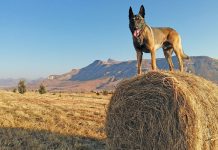Thicket is one of the richest but most poorly conserved biomes. Its high diversity of species is internationally recognised as being globally important, writes Cameron McMaster.
The highly diverse geological and climatic conditions prevailing in South Africa give rise to a large number of habitats and veld types. In his seminal work Veld Types of South Africa, John Acocks lists 70 veld types in Southern Africa. In the latest, very comprehensive publication by the South African National Biodiversity Institute, The Vegetation of South Africa, Lesotho and Swaziland, edited by Mucina and Rutherford, from which source much of the information for this article has been obtained, a staggering 435 vegetation types are listed under eight biomes.
The Thicket biome can be described as dense, woody, semi-succulent and thorny vegetation with an average height of 2m to 3m. Acocks recognised four vegetation types classified as thicket, namely Valley Bushveld, Noorsveld, Spekboomveld and Karroid Broken Veld. The Vegetation of South Africa, Lesotho and Swaziland classifies the Thicket biome into 14 vegetation units, stretching from the Gouritz Valley in the southern Cape to the Great Kei River Valley in the Eastern Cape. Since the thicket in the Grahamstown and Fish River region is so typical, the term Albany Thicket is often used.
A comprehensive biological survey in 2002 by Vlok and Euston-Brown, the Subtropical Thicket Ecosystem Planning Project (STEP), provided an even more detailed classification of the Thicket biome, listing over 50 vegetation types.
This is one of the smallest of our ecological regions, but one of the richest and most poorly conserved, in which the high species diversity is internationally recognised as being of global importance.
In their fascinating book Regions of Floristic Endemism in Southern Africa, published by Umdaus Press, Van Wyk and Smith list the Albany Centre as one of the regions with the highest number of endemic species – roughly 20%. Over 80% of the plant species in the Thicket biome have a very narrow distribution, with a great many listed as threatened on the current Red Data list.
A changing environment
Before European settlement the Thicket biome supported a large number of herbivores, such as elephant, black rhino, hippo, kudu, bushbuck and duiker.
The influx of Europeans brought radical land-use changes, with wild game systematically exterminated and replaced with large numbers of goats, sheep and cattle. With little understanding of the limited potential of the thicket to support commercial livestock, the region was grossly overstocked and severely degraded.
It was largely in the Thicket biome that the first encounters between Europeans and the Xhosa took place. Thicket supplied most of the needs of indigenous peoples in terms of grazing, food, cultural and ceremonial traditions, and also building material for their homes and kraals. The Xhosas possessed an intimate knowledge of wild plants and their uses.
Ever-expanding populations resulted in totally unsustainable harvesting of these resources in areas like the former Ciskei. Even as people moved to towns and cities they continued to depend on wild plants for medicinal and cultural purposes. There’s now an enormous demand for traditional medicine harvested in the wild and offered for sale in urban muthi markets.
Michelle Cocks, of the Institute of Social and Economic Research at Rhodes University, assisted by her husband Tony Dold, has made a comprehensive study of how biodiversity fulfils a range of livelihood and cultural needs in communities.
The growing importance of eco-tourism and the hunting industry has had positive implications for the restoration of thicket.
Large tracts have been converted to game reserves, lodges and national parks. Only pristine and sustainably-managed environments attract clients, so there’s a great incentive to restore thicket. As emphasis on eco-friendly production increases, livestock producers will have to comply with international norms. Due to its high carbon-storage capacity, spekboom (Portulacaria afra) restoring spekboom-dominated thicket could give farmers the opportunity to sell carbon credits.
Contact Cameron McMaster at [email protected]. |fw








